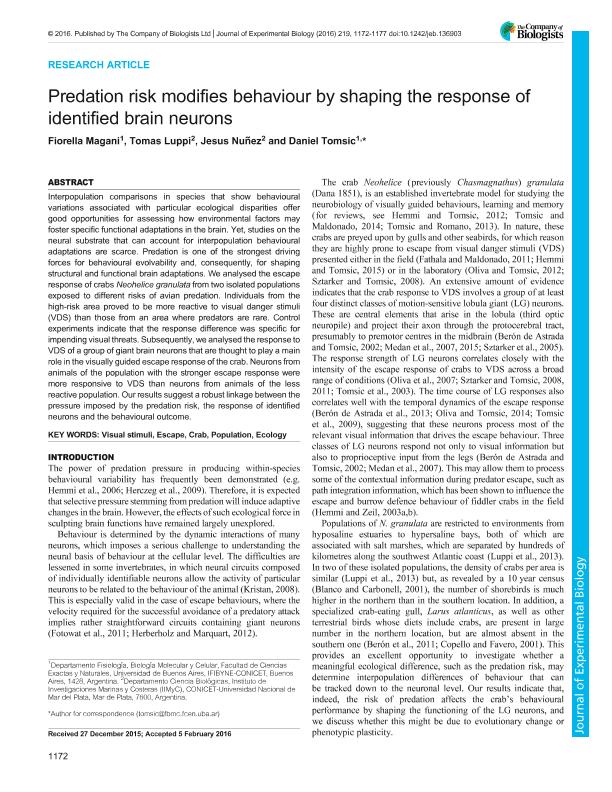Artículo
Predation risk modifies behaviour by shaping the response of identified brain neurons
Fecha de publicación:
02/2016
Editorial:
Company of Biologists
Revista:
Journal of Experimental Biology
ISSN:
0022-0949
e-ISSN:
1172-1177
Idioma:
Inglés
Tipo de recurso:
Artículo publicado
Clasificación temática:
Resumen
Interpopulation comparisons in species that show behavioural variations associated with particular ecological disparities offer good opportunities for assessing how environmental factors may foster specific functional adaptations in the brain. Yet, studies on the neural substrate that can account for interpopulation behavioural adaptations are scarce. Predation is one of the strongest driving forces for behavioural evolvability and, consequently, for shaping structural and functional brain adaptations. We analysed the escape response of crabs Neohelice granulata from two isolated populations exposed to different risks of avian predation. Individuals from the high-risk area proved to be more reactive to visual danger stimuli (VDS) than those from an area where predators are rare. Control experiments indicate that the response difference was specific for impending visual threats. Subsequently, we analysed the response to VDS of a group of giant brain neurons that are thought to play a main role in the visually guided escape response of the crab. Neurons from animals of the population with the stronger escape response were more responsive to VDS than neurons from animals of the less reactive population. Our results suggest a robust linkage between the pressure imposed by the predation risk, the response of identified neurons and the behavioural outcome.
Palabras clave:
Visual Stimuli
,
Escape
,
Crab
,
Population
,
Ecology
Archivos asociados
Licencia
Identificadores
Colecciones
Articulos(IFIBYNE)
Articulos de INST.DE FISIOL., BIOL.MOLECULAR Y NEUROCIENCIAS
Articulos de INST.DE FISIOL., BIOL.MOLECULAR Y NEUROCIENCIAS
Articulos(IIMYC)
Articulos de INSTITUTO DE INVESTIGACIONES MARINAS Y COSTERAS
Articulos de INSTITUTO DE INVESTIGACIONES MARINAS Y COSTERAS
Citación
Magani, Fiorella; Luppi, Tomas Atilio; Nuñez, Jesus Dario; Tomsic, Daniel; Predation risk modifies behaviour by shaping the response of identified brain neurons; Company of Biologists; Journal of Experimental Biology; 219; 2-2016; 1172-1177
Compartir
Altmétricas




